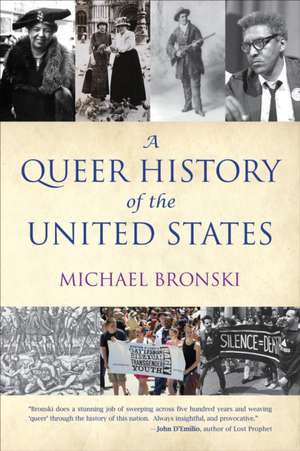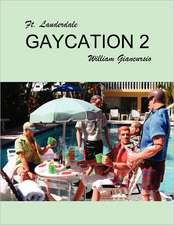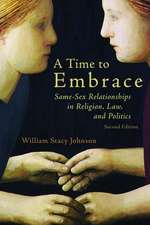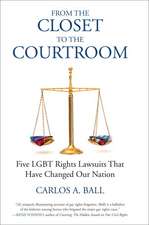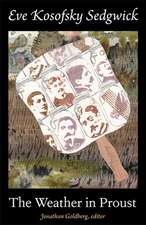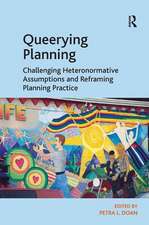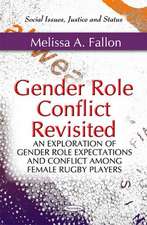A Queer History of the United States: Rebuilding Home in the Wake of Katrina: ReVisioning American History
Autor Michael Bronskien Limba Engleză Paperback – 19 iun 2012
Vezi toate premiile Carte premiată
Triangle Awards (2012), Lambda Literary Awards (2012)
A Queer History of the United States is more than a “who’s who” of queer history: it is a book that radically challenges how we understand American history. Drawing upon primary-source documents, literature, and cultural histories, scholar and activist Michael Bronski charts the breadth of lesbian, gay, bisexual, and transgender history, from 1492 to the 1990s.
Preț: 87.73 lei
Nou
Puncte Express: 132
Preț estimativ în valută:
16.79€ • 18.25$ • 14.11£
16.79€ • 18.25$ • 14.11£
Carte în stoc
Livrare din stoc 12 martie
Preluare comenzi: 021 569.72.76
Specificații
ISBN-13: 9780807044650
ISBN-10: 0807044652
Pagini: 287
Dimensiuni: 154 x 229 x 26 mm
Greutate: 0.48 kg
Editura: Beacon Press (MA)
Seria ReVisioning American History
ISBN-10: 0807044652
Pagini: 287
Dimensiuni: 154 x 229 x 26 mm
Greutate: 0.48 kg
Editura: Beacon Press (MA)
Seria ReVisioning American History
Recenzii
“Bronski does a stunning job of sweeping across five hundred years and weaving ‘queer’ through the history of this nation. Always insightful, and provocative.”—John D’Emilio, author of Lost Prophet
“The first book to cover all of LGBT history from 1492 through the present is Michael Bronski's A Queer History of the United States (Beacon Press). It is wonderfully readable and looks at the way we understand the history of the United States. The LGBT population moves from the margins to the mainstream and we see that the history of this country also is our history.”—Windy City Times
“Bronski's book provides an excellent overview for readers new to the field of gay history. Summing Up: Essential. All levels/libraries...”—CHOICE Magazine
“...A succinct distillation of the history of lesbians, gays, bisexuals, and transgenders in America… Bronski’s impeccable research bolsters his arguments… a useful handbook for LGBT activist groups and other interested members of the gay community.”—Boston Globe
“In the age of Twitter and reductive history, we need a complex, fully realized, radical reassessment of history—and A Queer History of the United States is exactly that. Along the way, there are enough revelations and reassessments to fuel dozens of arguments about how we got to where we are today. I don’t know when I have enjoyed a history so much.”—Dorothy Allison, author of Bastard Out of Carolina
“Bronski has that rare ability to comprehensively synthesize a large body of material without simplifying or distorting it, taking as much care with historical evidence as with the shifts in language necessary to accurately understand it.”—Martin Duberman, Distinguished Professor of History Emeritus, City University of New York
“This book is a revelation. Its lively and engaging narrative peels back layers of cultural interconnection—from the creation of corn flakes to curb masturbation to Bette Midler’s rise to stardom that started at a gay bathhouse—and much more. Bronski has a Zinn-like grasp of the ties that bind us all together and how to illuminate them on the page.”—Jewelle Gomez, activist and author of The Gilda Stories
“Bronski demonstrates with wit, insight, and impeccable scholarship that queer lives are, and always have been, woven into the very fabric of this country. Readable, radical, and smart—a must read.”—Alison Bechdel, author of Fun Home
“Elegant, insightfully selective, and unremittingly intelligent, Bronski’s survey—of the whys and the ways queer people’s work and struggle have been integral in forming what we call ‘the United States of America’—is an impressive and useful overview."—Samuel R. Delany, author of Times Square Red, Times Square Blue
“A savvy political, legal, literary (and even fashion) history, Bronski’s narrative is as intellectually rigorous as it is entertaining.”—Publishers Weekly, starred review
“Bronski does a stunning job of sweeping across five hundred years and weaving ‘queer’ through the history of this nation. Always insightful, and provocative.”—John D’Emilio, author of Lost Prophet
“[A] monumental achievement.”—The Bay Area Reporter
From the Hardcover edition.
“The first book to cover all of LGBT history from 1492 through the present is Michael Bronski's A Queer History of the United States (Beacon Press). It is wonderfully readable and looks at the way we understand the history of the United States. The LGBT population moves from the margins to the mainstream and we see that the history of this country also is our history.”—Windy City Times
“Bronski's book provides an excellent overview for readers new to the field of gay history. Summing Up: Essential. All levels/libraries...”—CHOICE Magazine
“...A succinct distillation of the history of lesbians, gays, bisexuals, and transgenders in America… Bronski’s impeccable research bolsters his arguments… a useful handbook for LGBT activist groups and other interested members of the gay community.”—Boston Globe
“In the age of Twitter and reductive history, we need a complex, fully realized, radical reassessment of history—and A Queer History of the United States is exactly that. Along the way, there are enough revelations and reassessments to fuel dozens of arguments about how we got to where we are today. I don’t know when I have enjoyed a history so much.”—Dorothy Allison, author of Bastard Out of Carolina
“Bronski has that rare ability to comprehensively synthesize a large body of material without simplifying or distorting it, taking as much care with historical evidence as with the shifts in language necessary to accurately understand it.”—Martin Duberman, Distinguished Professor of History Emeritus, City University of New York
“This book is a revelation. Its lively and engaging narrative peels back layers of cultural interconnection—from the creation of corn flakes to curb masturbation to Bette Midler’s rise to stardom that started at a gay bathhouse—and much more. Bronski has a Zinn-like grasp of the ties that bind us all together and how to illuminate them on the page.”—Jewelle Gomez, activist and author of The Gilda Stories
“Bronski demonstrates with wit, insight, and impeccable scholarship that queer lives are, and always have been, woven into the very fabric of this country. Readable, radical, and smart—a must read.”—Alison Bechdel, author of Fun Home
“Elegant, insightfully selective, and unremittingly intelligent, Bronski’s survey—of the whys and the ways queer people’s work and struggle have been integral in forming what we call ‘the United States of America’—is an impressive and useful overview."—Samuel R. Delany, author of Times Square Red, Times Square Blue
“A savvy political, legal, literary (and even fashion) history, Bronski’s narrative is as intellectually rigorous as it is entertaining.”—Publishers Weekly, starred review
“Bronski does a stunning job of sweeping across five hundred years and weaving ‘queer’ through the history of this nation. Always insightful, and provocative.”—John D’Emilio, author of Lost Prophet
“[A] monumental achievement.”—The Bay Area Reporter
From the Hardcover edition.
Notă biografică
Michael Bronski is professor of practice in media and activism in the Women, Gender, and Sexuality Program at Harvard University. He has written extensively on LGBT issues for four decades, in both mainstream and queer publications, and is the author of three other books and editor of several anthologies.
Extras
From Chapter 3: Imagining a Queer America
Writing a New National Culture: The East
Paradoxically, as westward expansion made the country geographically larger, new technologies—the invention of the telegraph in the late 1830s, the growth of a national railway system, and the telephone in the 1870s—facilitated travel and communications, making the country smaller and more cohesive. In these conditions we see the eventual flourishing of a distinctly American intellectual and literary culture. Washington Irving’s 1820 short story “The Legend of Sleepy Hollow” promotes the ideal of robust, decidedly heterosexual masculinity, as embodied by “Brom Bones” Van Brunt, over that of the lanky, effeminized schoolteacher Ichabod Crane. Both men are courting young Katrina Van Tassel until Brom Bones frightens Crane out of town. Irving’s gender and sexual message is clear. Crane’s first name means “inglorious” in Hebrew, which Bible-literate contemporary readers would know. And as literary critic Caleb Crain points out, much of the action of the story takes place by “Major Andre’s tree.” This is a reference to Major John Andre, the British officer—generally thought to be a lover of men—who collaborated with Benedict Arnold and was hanged by George Washington as a spy in 1780.7 For Irving, nearly four decades after the Revolution, the new, clearly heterosexual American man was an imperative.
In contrast to Irving, also in 1820, nineteen-year-old Harvard student Ralph Waldo Emerson was writing entries in his journal about Martin Gay, a fellow student three years younger to whom he was attracted. Two years earlier, when he had first seen Gay, Emerson wrote:
I begin to believe in the Indian doctrine of eye-fascination. The cold blue eye of [Emerson deleted the name here] has so intimately connected him to my thoughts & visions that a dozen times a day & as often . . . by night I have found myself wholly wrapped up in conjectures of his character and inclinations. . . . We have had already two or three profound stares at one another. Be it wise or weak or superstitious I must know him.
Crain notes that Emerson’s attraction to Gay was a form of the nineteenth-century ideal of “sympathy.” In this context, sympathy— a form of empathy that, as Crain writes, “allows us to feel emotions that are not ours”—is an expansive form of romantic friendship. The deeply felt connective emotion of sympathy allows one to not only value a friend for his or her emotional sincerity, but to take imaginative leaps toward understanding and sharing the emotions of another. This new understanding of the possibilities of shared emotion was likely inflected by the new America of wide-open western spaces, natural landscape, and the outlaw.
In 1837 Emerson published “Nature,” an essay fundamental in defining transcendentalism: the distinctly American philosophy promoting individual spiritual transcendence through experiencing the material world, especially nature, rather than through organized religion. The next year, in his “American Scholar” speech, he urged his audience to rethink the idea of the American man (by which he meant humans) and to create an independent, original, and free national literature. Animated by the ideal of an expansive sympathy influenced by the “naturalness” of America, Emerson argued for an egalitarian society that values all of its members’ individual contributions to a whole: the doctrine “that there is One Man,—present to all particular men only partially, or through one faculty; and that you must take the whole society to find the whole man. Man is not a farmer, or a professor, or an engineer, but he is all. Man is priest, and scholar, and statesman, and producer, and soldier.”
Emerson’s vision of American equality, the basis for his strong antislavery and proߝwomen’s suffrage beliefs, has roots in the Enlightenment and in his radical, nature-based vision of Christianity. But it is especially rooted in his ability to admit and emotionally explore his attraction to—his sympathy with—other men. Samesex affection was integral to understanding the mutually beneficent dynamics of the individual in society. This egalitarian same-sex affection placed the rugged individualism of the Revolutionary man into a new context, not of conquering an American landscape but of emerging from it and being at one with it. This was the cornerstone of a new way of understanding gender, desire, and personal and social liberty.
The feelings Emerson had for Martin Gay (his journals indicate “sympathy” for other young men as well) did not stop him from marrying twice and fathering four children. Emerson did not easily embrace all aspects of this sympathy. In 1824 he wrote in his journal, “He that loosely forgets himself here & lets his friend be privy to his words & acts which base desires extort from him has forfeited like a fool the love he prized.” This is an example of an internal tension that reflected a larger tension between sympathy and overt sexuality: that is, moving from a private emotion to publicly expressing that emotion.
Emerson was not the only person dealing with this conflation of desires, emotions, and political ideas. A wealth of homoerotic sentiments are present in the poems and journals of Henry David Thoreau. Meditations on friendship run throughout his journal, and by the 1840s they became increasingly erotic: “Feb. 18 [1840]. All romance is grounded on friendship. What is this rural, this pastoral, this poetical life but its invention? Does not the moon shine for Endymion? Smooth pastures and mild airs are for some Corydon and Phyllis. Paradise belongs to Adam and Eve. Plato’s republic is governed by Platonic love.”
Thoreau’s invoking of Endymion, Corydon, and Plato strongly suggests a homosexual subtext; the two mythological figures were iconic representations for same-sex male desire in Renaissance art, and the Republic was, in part, an analysis of male friendship and love. Thoreau is using friendship as a metaphor here. However, his attraction to the eroticized male body appears throughout his journals without mythological trappings, but rather with a decidedly transcendentalist bent:
[June 12, 1852.] Boys are bathing in Hubbard’s Bend, playing with a boat (I at the willows). The color of their bodies in the sun at a distance is pleasing, the not often seen flesh-color. I hear the sound of their sport borne over the water. As yet we have not man in nature. What a singular fact for an angel visitant to this earth to carry back in his note-book, that men were forbidden to expose their bodies under the severest penalties! A pale pink, which the sun would soon tan. White men! There are no white men to contrast with the red and the black; they are of such colors as the weaver gives them. I wonder that the dog knows his master where he goes in to bathe and does not stay by his clothes.
Thoreau’s message is that civilization, with its “severest penalties,” is most unnatural. He is arguing that nature not only allows for “exposure” but is a space for racial equality, one wherein even the idea of “whiteness” is exposed as a lie. Alluding to classical literature and the European culture it inspired was a common method for nineteenth-century American intellectuals to discuss sexuality and sexual behaviors. Used consciously to reinforce ideas about American citizenship and democratic structures, the older culture safely places the sexuality at a distance.
Margaret Fuller, a leading figure in the transcendentalist movement and author of Women of the Nineteenth Century, the first major feminist publication in the United States, was also connecting to same-sex erotic intimacy and a new American ideal. In 1843, several years after viewing Danish sculptor Bertel Thorvaldsen’s Ganymede at a Boston exhibition, Fuller wrote “Ganymede to His Eagle,” a poem about the beautiful boy abducted by Zeus, in the form of an eagle, to be his lover and cupbearer. Here the cupbearer speaks to the eagle:
Before I saw thee, I was like the May,
Longing for summer that must mar its bloom,
Or like the morning star that calls the day,
Whose glories to its promise are the tomb;
And as the eager fountain rises higher
To throw itself more strongly back to earth,
Still, as more sweet and full rose my desire,
More fondly it reverted to its birth,
For, what the rosebud seeks tells not the rose,
The meaning foretold by the boy the man cannot disclose.
Caleb Crain notes that Fuller is referring not only to the implicit homoeroticism of the original myth but, more important, to the eagle as “the emblem of sovereignty of the United States.” Thus she consciously conflates mythological same-sex desire with the democratic progress of the nation. Fuller is indicating that the longing for freedom implicit in same-sex desire and sympathy cannot be fully expressed—the rosebud cannot tell the rose what it feels—because its power, at root political, emanates from being unspoken. In much of this literature is an underlying assumption that unspoken feelings are stronger than articulated ones. In 1839, at the age of twentynine, Fuller wrote to a woman friend of long standing:
With regard to yourself, I was to you all that I wished to be. I knew that I reigned in your thoughts in my own way. And I also lived with you more truly and freely than with any other person. We were truly friends, but it was not friends as men are friends to one another, or as brother and sister. There was, also, that pleasure, which may, perhaps, be termed conjugal, of finding oneself in an alien nature. Is there any tinge of love in this? Possibly!
From the Hardcover edition.
Writing a New National Culture: The East
Paradoxically, as westward expansion made the country geographically larger, new technologies—the invention of the telegraph in the late 1830s, the growth of a national railway system, and the telephone in the 1870s—facilitated travel and communications, making the country smaller and more cohesive. In these conditions we see the eventual flourishing of a distinctly American intellectual and literary culture. Washington Irving’s 1820 short story “The Legend of Sleepy Hollow” promotes the ideal of robust, decidedly heterosexual masculinity, as embodied by “Brom Bones” Van Brunt, over that of the lanky, effeminized schoolteacher Ichabod Crane. Both men are courting young Katrina Van Tassel until Brom Bones frightens Crane out of town. Irving’s gender and sexual message is clear. Crane’s first name means “inglorious” in Hebrew, which Bible-literate contemporary readers would know. And as literary critic Caleb Crain points out, much of the action of the story takes place by “Major Andre’s tree.” This is a reference to Major John Andre, the British officer—generally thought to be a lover of men—who collaborated with Benedict Arnold and was hanged by George Washington as a spy in 1780.7 For Irving, nearly four decades after the Revolution, the new, clearly heterosexual American man was an imperative.
In contrast to Irving, also in 1820, nineteen-year-old Harvard student Ralph Waldo Emerson was writing entries in his journal about Martin Gay, a fellow student three years younger to whom he was attracted. Two years earlier, when he had first seen Gay, Emerson wrote:
I begin to believe in the Indian doctrine of eye-fascination. The cold blue eye of [Emerson deleted the name here] has so intimately connected him to my thoughts & visions that a dozen times a day & as often . . . by night I have found myself wholly wrapped up in conjectures of his character and inclinations. . . . We have had already two or three profound stares at one another. Be it wise or weak or superstitious I must know him.
Crain notes that Emerson’s attraction to Gay was a form of the nineteenth-century ideal of “sympathy.” In this context, sympathy— a form of empathy that, as Crain writes, “allows us to feel emotions that are not ours”—is an expansive form of romantic friendship. The deeply felt connective emotion of sympathy allows one to not only value a friend for his or her emotional sincerity, but to take imaginative leaps toward understanding and sharing the emotions of another. This new understanding of the possibilities of shared emotion was likely inflected by the new America of wide-open western spaces, natural landscape, and the outlaw.
In 1837 Emerson published “Nature,” an essay fundamental in defining transcendentalism: the distinctly American philosophy promoting individual spiritual transcendence through experiencing the material world, especially nature, rather than through organized religion. The next year, in his “American Scholar” speech, he urged his audience to rethink the idea of the American man (by which he meant humans) and to create an independent, original, and free national literature. Animated by the ideal of an expansive sympathy influenced by the “naturalness” of America, Emerson argued for an egalitarian society that values all of its members’ individual contributions to a whole: the doctrine “that there is One Man,—present to all particular men only partially, or through one faculty; and that you must take the whole society to find the whole man. Man is not a farmer, or a professor, or an engineer, but he is all. Man is priest, and scholar, and statesman, and producer, and soldier.”
Emerson’s vision of American equality, the basis for his strong antislavery and proߝwomen’s suffrage beliefs, has roots in the Enlightenment and in his radical, nature-based vision of Christianity. But it is especially rooted in his ability to admit and emotionally explore his attraction to—his sympathy with—other men. Samesex affection was integral to understanding the mutually beneficent dynamics of the individual in society. This egalitarian same-sex affection placed the rugged individualism of the Revolutionary man into a new context, not of conquering an American landscape but of emerging from it and being at one with it. This was the cornerstone of a new way of understanding gender, desire, and personal and social liberty.
The feelings Emerson had for Martin Gay (his journals indicate “sympathy” for other young men as well) did not stop him from marrying twice and fathering four children. Emerson did not easily embrace all aspects of this sympathy. In 1824 he wrote in his journal, “He that loosely forgets himself here & lets his friend be privy to his words & acts which base desires extort from him has forfeited like a fool the love he prized.” This is an example of an internal tension that reflected a larger tension between sympathy and overt sexuality: that is, moving from a private emotion to publicly expressing that emotion.
Emerson was not the only person dealing with this conflation of desires, emotions, and political ideas. A wealth of homoerotic sentiments are present in the poems and journals of Henry David Thoreau. Meditations on friendship run throughout his journal, and by the 1840s they became increasingly erotic: “Feb. 18 [1840]. All romance is grounded on friendship. What is this rural, this pastoral, this poetical life but its invention? Does not the moon shine for Endymion? Smooth pastures and mild airs are for some Corydon and Phyllis. Paradise belongs to Adam and Eve. Plato’s republic is governed by Platonic love.”
Thoreau’s invoking of Endymion, Corydon, and Plato strongly suggests a homosexual subtext; the two mythological figures were iconic representations for same-sex male desire in Renaissance art, and the Republic was, in part, an analysis of male friendship and love. Thoreau is using friendship as a metaphor here. However, his attraction to the eroticized male body appears throughout his journals without mythological trappings, but rather with a decidedly transcendentalist bent:
[June 12, 1852.] Boys are bathing in Hubbard’s Bend, playing with a boat (I at the willows). The color of their bodies in the sun at a distance is pleasing, the not often seen flesh-color. I hear the sound of their sport borne over the water. As yet we have not man in nature. What a singular fact for an angel visitant to this earth to carry back in his note-book, that men were forbidden to expose their bodies under the severest penalties! A pale pink, which the sun would soon tan. White men! There are no white men to contrast with the red and the black; they are of such colors as the weaver gives them. I wonder that the dog knows his master where he goes in to bathe and does not stay by his clothes.
Thoreau’s message is that civilization, with its “severest penalties,” is most unnatural. He is arguing that nature not only allows for “exposure” but is a space for racial equality, one wherein even the idea of “whiteness” is exposed as a lie. Alluding to classical literature and the European culture it inspired was a common method for nineteenth-century American intellectuals to discuss sexuality and sexual behaviors. Used consciously to reinforce ideas about American citizenship and democratic structures, the older culture safely places the sexuality at a distance.
Margaret Fuller, a leading figure in the transcendentalist movement and author of Women of the Nineteenth Century, the first major feminist publication in the United States, was also connecting to same-sex erotic intimacy and a new American ideal. In 1843, several years after viewing Danish sculptor Bertel Thorvaldsen’s Ganymede at a Boston exhibition, Fuller wrote “Ganymede to His Eagle,” a poem about the beautiful boy abducted by Zeus, in the form of an eagle, to be his lover and cupbearer. Here the cupbearer speaks to the eagle:
Before I saw thee, I was like the May,
Longing for summer that must mar its bloom,
Or like the morning star that calls the day,
Whose glories to its promise are the tomb;
And as the eager fountain rises higher
To throw itself more strongly back to earth,
Still, as more sweet and full rose my desire,
More fondly it reverted to its birth,
For, what the rosebud seeks tells not the rose,
The meaning foretold by the boy the man cannot disclose.
Caleb Crain notes that Fuller is referring not only to the implicit homoeroticism of the original myth but, more important, to the eagle as “the emblem of sovereignty of the United States.” Thus she consciously conflates mythological same-sex desire with the democratic progress of the nation. Fuller is indicating that the longing for freedom implicit in same-sex desire and sympathy cannot be fully expressed—the rosebud cannot tell the rose what it feels—because its power, at root political, emanates from being unspoken. In much of this literature is an underlying assumption that unspoken feelings are stronger than articulated ones. In 1839, at the age of twentynine, Fuller wrote to a woman friend of long standing:
With regard to yourself, I was to you all that I wished to be. I knew that I reigned in your thoughts in my own way. And I also lived with you more truly and freely than with any other person. We were truly friends, but it was not friends as men are friends to one another, or as brother and sister. There was, also, that pleasure, which may, perhaps, be termed conjugal, of finding oneself in an alien nature. Is there any tinge of love in this? Possibly!
From the Hardcover edition.
Cuprins
Author’s Note
Introduction
One: The Persecuting Society
Two: Sexually Ambiguous Revolutions
Three: Imagining a Queer America
Four: A Democracy of Death and Art
Five: A Dangerous Purity
Seven: Production and Marketing of Gender
Eight: Sex in the Trenches
Nine: Visible Communities/Invisible Lives
Ten: Revolt/Backlash/Resistance
Epilogue
Acknowledgments
Notes
Credits
Index
Introduction
One: The Persecuting Society
Two: Sexually Ambiguous Revolutions
Three: Imagining a Queer America
Four: A Democracy of Death and Art
Five: A Dangerous Purity
Seven: Production and Marketing of Gender
Eight: Sex in the Trenches
Nine: Visible Communities/Invisible Lives
Ten: Revolt/Backlash/Resistance
Epilogue
Acknowledgments
Notes
Credits
Index
Premii
- Triangle Awards Finalist, 2012
- Lambda Literary Awards Winner, 2012
